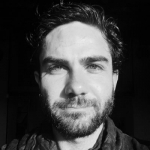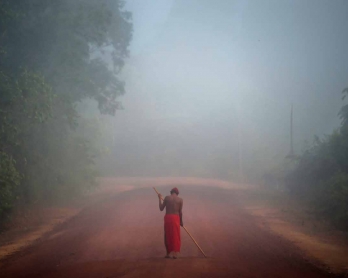Broken-Foot’s adventures in the Amazon
Altamira, Brazil -- After five years as a video journalist in South America, I’ve found that a healthy dose of humor is essential for the job. To help digest “heavy” topics like conflict, disasters and politics, but often just to get through a dreamy assignment that goes off kilter because of one little slip.
I realized I had weak ankles the first time I fell in the Amazon. That was two years ago. We were rushing back to our boats after filming fishermen catch giant arapaima (100kg a fish!) in an inland lake.
 Fishermen pull up a live 2.5 metre crocodile in their net in the Western Amazon region, Brazil on September 20, 2017. (AFP / Carl De Souza)
Fishermen pull up a live 2.5 metre crocodile in their net in the Western Amazon region, Brazil on September 20, 2017. (AFP / Carl De Souza)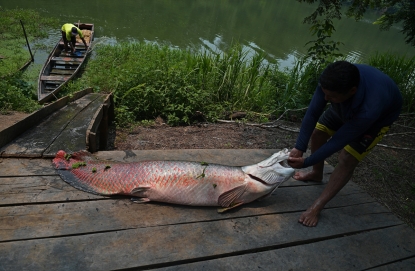 Fishermen drag to a dock a recenly catched arapaima, also known as pirarucu, in the Western Amazon region near Volta do Bucho in the Ituxi Reserve on September 20, 2017. (AFP / Carl De Souza)
Fishermen drag to a dock a recenly catched arapaima, also known as pirarucu, in the Western Amazon region near Volta do Bucho in the Ituxi Reserve on September 20, 2017. (AFP / Carl De Souza)
One moment I was walking merrily along, the next I lay prostrate. My photographer colleague gallantly carried my tripod the rest of the trip.
Then I fell again on my second trip to the storied region. I went with a text and photographer colleagues to the remote town of Altamira in northern Brazil to report on indigenous peoples’ land rights and illegal deforestation. This time I thought I was prepared: reinforced hiking boots, better-chosen luggage and two years’ worth of wisdom.
I was wrong.
Five minutes after stepping ashore on land of the indigenous Arara people, four hours by boat from Altamira, I was filming locals disembarking from a little river boat. Some offloaded dead monkeys which they had brought to cook. Curious at this novel subject, I rushed to film different angles for a good sequence. I heard a crack, wondered if it were my ankle, and went down in the mud. My colleagues helped me up and picked up my camera. I noticed it was still filming, pointing straight at me in my moment of ignominy.
Eager hands helped me up the embankment where I sat under a tree until our guide came by with a motorcycle to take me to the local clinic.
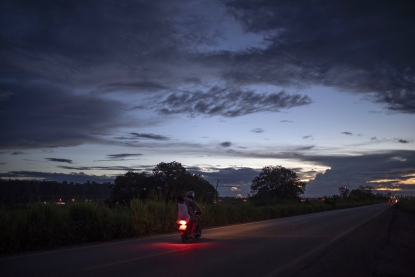 A motorcycle rides along a road heading to Altamira, Para State, Brazil on March 10, 2019. (AFP / Mauro Pimentel)
A motorcycle rides along a road heading to Altamira, Para State, Brazil on March 10, 2019. (AFP / Mauro Pimentel)Like some other Amazon tribes, the Arara mix the traditional and the modern. Their village has a government school and clinic, young people watch music videos on smartphones, but then they love going on hunting excursions together. A diesel generator provides electricity for around three hours at night. Most are dressed in Western style, while some wear parrot feathers on their heads.
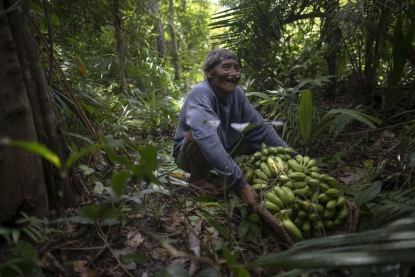 An Arara indigenous man collects bananas near the Laranjal tribal camp, in Arara indigenous land, Para state, in the northern Brazilian Amazon rainforest, on March 14, 2019. (AFP / Mauro Pimentel)
An Arara indigenous man collects bananas near the Laranjal tribal camp, in Arara indigenous land, Para state, in the northern Brazilian Amazon rainforest, on March 14, 2019. (AFP / Mauro Pimentel)They were proud of their clinic, where a government nurse lives around the clock. But she didn’t have any ice, that effective remedy for twisted ankles. So she poured some ice water in a latex surgical glove, which I held to my foot. Curious kids were always around. Later I would play by throwing the water-filled glove at them while holding onto one end. Shrieks of laughter.
That night I discovered they’d come up with a name for me: ‘Pe quebrado’, Portuguese for Broken Foot. ‘Where’s Broken Foot’, they’d ask my colleagues if I disappeared for a while.
Luckily the injury came toward the end of our trip. The visit to their village was the last stretch. It still really complicated the work though. It’s tough to hop around on uneven ground while holding a camera and a tripod. We followed an elder into the forest on his way to cut some bananas. I fell hopelessly behind. At some point I commandeered a little helper from among the children.
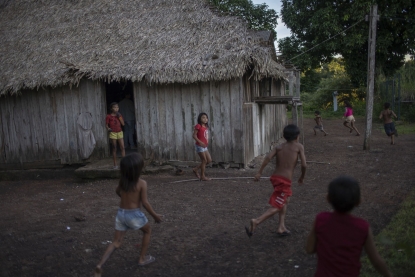 Arara indigenous children play at the Laranjal village, in Arara indigenous land, Para state, in the northern Brazilian Amazon rainforest, on March 14, 2019. (AFP / Mauro Pimentel)
Arara indigenous children play at the Laranjal village, in Arara indigenous land, Para state, in the northern Brazilian Amazon rainforest, on March 14, 2019. (AFP / Mauro Pimentel)The afternoon there was a commotion. We were talking quietly with the nurse at the clinic, when all of a sudden the entire village dashed into the trees, each person in a different direction. The men ran with spears and guns in their hands. They seemed excited. My colleagues pursued one group. Cursing myself again for having fallen, I decided to hop the other way, hoping to double up on the way or somehow run into a returning group. In the meantime I would film some of the forest’s beauty.
My hope evaporated when I saw numerous arteries snaking out from the main path. How would I know which one to take? I would never catch up. Feeling sorry for myself, I set to shoot a beautiful butterfly up close, some strange coconut-ish fruit hanging from a palm tree, the sunlight falling through the canopy.
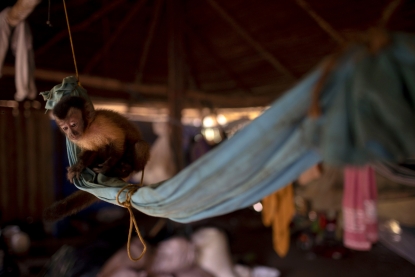 A monkey is seen inside a traditional Arara indigenous house at the Tagagem tribal camp, in Arara indigenous land, located beside the Transamazonica highway (BR-230), between the cities of Uruara and Medicilandia, in Para state, Brazil on March 13, 2019. (AFP / Mauro Pimentel)
A monkey is seen inside a traditional Arara indigenous house at the Tagagem tribal camp, in Arara indigenous land, located beside the Transamazonica highway (BR-230), between the cities of Uruara and Medicilandia, in Para state, Brazil on March 13, 2019. (AFP / Mauro Pimentel)A little later I heard voices and footsteps and rushed back to the main path. The men were coming back, empty-handed, yet strangely self-content. A few minutes behind them trailed the women and children, carrying cut-up pieces of a warthog carcass. Wide smiles. Two ladies balanced a pole on their shoulders, front and rear, with a hanging chunk of meat. A child holding a severed leg grinned at me.
They offered us a cut of their hunt, but because of a misunderstanding we ended up without the meat, and my mouth still waters today at the thought of that wild boar.
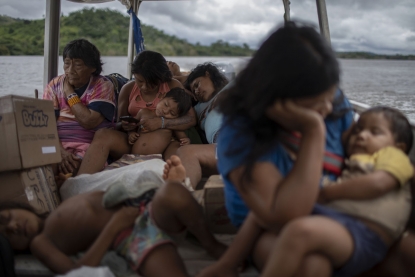 Arara indigenous people travel on a boat back to the Laranjal tribal camp, in Arara indigenous land, Para state, in the northern Brazilian Amazon rainforest, on March 15, 2019. (AFP / Mauro Pimentel)
Arara indigenous people travel on a boat back to the Laranjal tribal camp, in Arara indigenous land, Para state, in the northern Brazilian Amazon rainforest, on March 15, 2019. (AFP / Mauro Pimentel)A few days later, after the four hour boat trip and three airplane flights, I arrived home in Sao Paulo. Upon my bosses’ insistence I went to the doctor to have the foot checked out and got to know Brazil’s intricate healthcare system, but that’s a story for another day.
Doctor Roque said I’d sprained the ankle and fractured the bone where the leg and heel connect. Couldn’t have been too serious, though, because the good doctor sent me straight back to work, didn’t even book me off.
My fall came at the end of my assignment, after I had already filmed essential interviews and images of Amazon's astonishing scale of deforestation. So it didn’t affect my work on that particular story in a major way. But it did affect my work at that last village, as I didn't get all the images and interviews I wanted. On the other hand, it helped me connect more with the people whose language I did not speak and whose kids first ran away from me, crying, when they saw the strange foreign guy with the large camera. I think that my getting hurt reminded everyone that we were all alike.


